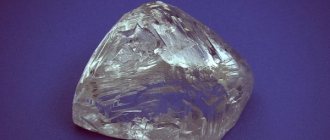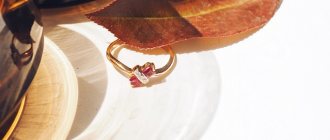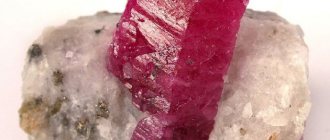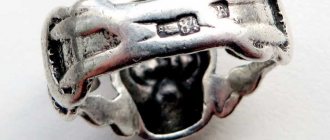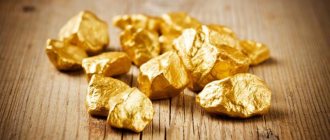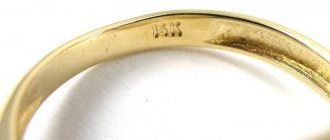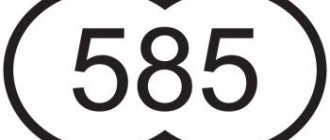| Stone type | Precious |
| Prevalence (Deposits) | Australia, Brazil, Kazakhstan, Canada, Russia, USA, South Africa |
| Varieties | Ballas, Bort, Diamond, Carbonado, Yakutite |
| Transparency | Transparent |
| Shine | Glass |
| Mohs hardness scale | 10 |
| Chemical composition | WITH |
| Color | White, blue, yellow, green, red, pink, blue, black |
| Owner's color type | Summer |
| Owner's temperament | Choleric |
| Names | Venus, Daria, Ivan, Ilya, Inna, Karina, Christina, Leo, Maria, Olympics, Sergey, Eduard |
| Zodiac sign | Aries, Leo, Sagittarius |
| Date of Birth | from March 21 to April 19 from July 23 to August 21 from November 22 to December 21 |
| Chinese horoscope | Rat, rooster, tiger |
| Element | Fire |
| Planet | Not found |
| Day of the week | Monday, Friday, Saturday, Sunday |
| Month | April, October |
| Season | Spring, autumn |
| Numerology vibration | 4, 6, 9 |
| Chakra | Sahasrara |
| What stones is it compatible with? | Agate, alabaster, amethyst, white pearl, beryl, turquoise, emerald, coral, lapis lazuli, sapphire, carnelian |
| What stones is it not compatible with? | Malachite, marcasite, obsidian, onyx, sardonyx |
| Therapeutic effect (problems) | Blood pressure, insomnia, immunity, nervous disorders, stress |
| Therapeutic effect (on organs) | Skin, respiratory organs, gastrointestinal tract organs, cardiovascular system |
| Magic properties | Strengthening relationships, finances, black magic, energy depletion |
Red diamond is a very rare mineral, which leads to its high price.
Due to its bright color, it attracts the attention and glances of others. In the jewelry community, it is considered a great honor to participate in the cutting of a red diamond. In this article we will analyze the origin and main properties of the diamond stone, who it is suitable for and the average cost of such a stone. The selection rules will allow you to distinguish the original crystal from a fake.
How red diamonds are formed
Diamonds are naturally occurring carbon minerals and are the hardest substance in nature.
Red diamonds were formed in geologically neutral areas of continents, their depth is approximately 100-200 km (the temperature reaches 1100-1300 ° C, and the total pressure is 35-50 Kbar). Such conditions activate the transition of carbon molecules from the graphite form to another form - diamond. Such stones have a dense cubic structure.
After billions of years in such conditions, diamonds rise closer to the surface along with kimberlite magma during volcanic explosions. In this case, special deposits are formed - kimberlite pipes.
For the first time such a place was discovered in South Africa (Kimberley province), which served as the name for such a breed. Nowadays, a huge number of kimberlite pipes have been found all over the globe, but only a few of them are industrially mined for diamonds.
Must see: Origins, varieties and healing powers of green jade
Among the general majority, red stones are quite rare, so the value is much higher than that of the classic options. The color of such crystals is affected by special combinations of impurities and various crystal lattice anomalies that appear during the formation of gems. The red and bright pink hue is due to inclusions of natural manganese, but no such impurity was found in the composition of scarlet diamonds.
The diamond mining process is very complex and labor-intensive, and also requires significant costs at the initial development stage.
Assessing the quality of red gemstones
Color
Gemologists evaluate color based on hue, hue, and saturation. Gemstones often have a secondary shade in addition to the primary one. In red gemstones, the most common secondary hues are purple and orange. Connoisseurs consider the best stones to be pure red or red with a slight hint of purple. As the hue moves away from this ideal, the value of the mineral decreases. This is not to say that purple-red and orange-red stones are not beautiful in themselves. In fact, few gemstones come close to the perfect red color.
Ruby is one of the red gemstones that can achieve high color saturation. © CustomMade
Red hues reach their gamut limit, or maximum saturation, at about 75 – 80% hue. This means that the color red can be most intense when it is medium-dark (example: a red traffic light). A darker red will be closer to brown. Light red shades (less than 50% of the tone) are pink. Although gemologists debate the difference between red and pink, in this article we will focus on red and darker tones.
This red spinel has a gorgeous color. © Johnny Brookheart
Purity
Clarity is less important for red gemstones than for colorless gemstones such as diamond. A darker color helps hide imperfections in the stone. However, avoid large inclusions or cracks as they can make the stone more brittle. In addition, visible inclusions in the center of the stone will be more noticeable than inclusions on the sides.
Color spectrum
Of all fancy (i.e. colored) diamonds, red diamonds are the most valuable to collectors. They can have the following shades:
- pink;
- purple;
- red-brown.
The main condition is that such crystals should be dominated by a pure shade of red. Red diamonds, even with impurities, are valued only individually. However, only copies with a Fancy Red certificate (pure, without impurities) are considered unique.
Interesting! At the moment, only 50 pure red gemstones are known, but the US Gemological Institute has certified only 20 stones throughout its existence (about 90 years). The remaining minerals are considered lost.
Plant characteristics
As you can see in the photo, the Cordes diamond rose is a tall shrub, reaching a height of one and a half meters, with long, upward-pointing elastic branches, densely covered with bright emerald, glossy leaves of medium size, oval-elongated. The Cordes diamond rose blooms continuously throughout the summer, extending into September. Even if you do not cut off the fading buds, the plant will not stop producing flowering shoots. The buds are collected in brushes. Up to three cup-shaped flowers are formed on one shoot. The diameter of the flower is on average about nine centimeters. The flowers of this variety are lush and double. One bud can contain up to forty petals. On average, each bud lives about two weeks.
Each flower of the Cordes diamond rose is worthy of a separate description. The color of the buds ranges from red or fiery orange to scarlet. In bright sunlight, the flowers seem to shimmer and seem to be illuminated from the inside. The width of each bush reaches seventy centimeters, which must be taken into account when planting in groups.
Cut and setting
Red diamonds reveal their beauty when cut correctly when they turn into diamonds. Fantasy stones require the most careful and thoughtful work, because... intricate cuts can significantly reduce the size of the gem.
Cut options
Scarlet diamonds are small in size. For this reason, the most gentle methods are used for cutting - such crystals are processed in the shape of a circle, oval or cabachon.
By their nature, red diamonds lack some of the sparkle compared to colorless varieties. Therefore, for large stones, special methods are used to increase sparkle. For example, mixed technique - the upper part remains as even and smooth as possible, the part in the frame acquires many edges. This helps create an internal glow and additional shimmer in the light.
Red diamonds are processed only by top-class craftsmen with many years of experience, and the work itself can take from 1 month to a whole year.
Such diamonds should be framed with gold and platinum. Considering the high cost of such a crystal, it makes no sense to save on the frame.
Application
Humanity has been using diamonds not as inserts in jewelry and decorative objects for more than two centuries. Until about the middle of the 20th century, this mineral was in demand exclusively in jewelry.
Diamonds
Initially, diamonds were kept in their original form in the treasuries of the kings, and they learned to process them only in the 15th century.
Belgian polishers from the city of Bruges were the first to turn a diamond into a diamond. They also came up with the famous diamond cut, which includes 57 facets.
Diamond cut 57 facets
There is a certain division of professional cutters in the world:
- Small stones (up to 0.3 carats) are cut in the East (India, China and Thailand).
- American cutters work only with large specimens.
- Russia, as well as Belgium, undertake the processing of medium and large stones.
The resulting diamonds are set into luxury items made from precious metals.
Other areas
Pear-shaped cut diamond
To turn a found stone into a diamond, you need to use its fellow stone, since there is nothing harder than a diamond. It was the exceptional hardness of the stone that prompted scientists to study its other properties and search for its use in other areas.
Today diamonds are used:
- In construction, this is diamond cutting, drilling or dismantling of durable concrete and steel structures, allowing work to be carried out without the formation of cracks and other defects. And also for laying tunnels created by a road-going machine with a huge diamond-coated disk.
- In medicine. Examples are a perfectly sharp and virtually undull diamond scalpel, laser devices in which the stone serves as an active conductor.
- In telecommunications, electronics and optics, where the mineral’s high thermal conductivity and ability to overcome strong voltage surges are used.
- In physics and chemistry as a protective screen for minerals that can be damaged by aggressive environments, as well as in scientific experiments of various types that require the absence of errors.
- In the field of mining, where the mineral is indispensable for laying pipes, drilling, and overcoming hard formations in the soil that hardened steel cannot handle.
- In precision instrument making and heavy engineering. The exceptional hardness and wear resistance of the mineral allows it to be used to create components for various devices and instruments - from surgical scalpels to space carriers.
In Russia, more than 1,200 different tools are made using diamonds (natural or synthesized) - scissors and saws for metal or stone, grinding wheels, glass cutters, drills, cutters and much more.
It is irrational to use natural diamonds in industry due to their high cost. Therefore, today (since 1953) synthesized gems are actively used for these purposes (97%).
Medicinal properties
The unique properties of this stone are due to its color. Like other red minerals, this diamond has a positive effect on the cardiovascular system:
- strengthens the walls of blood vessels and small capillaries;
- normalizes changes in blood pressure;
- improves blood circulation in the extremities;
- increases decreased hemoglobin;
- improves the chemical composition of the blood and promotes hematopoietic processes;
- helps strengthen the heart muscle - prevention of myocardial infarction.
The rarest stone - RED DIAMONDOne of the rarest and most expensive gems, and to some extent...
Published by Geology Museum of Central Siberia GEOS Thursday, June 2, 2021
For a healing effect, such a stone requires regular contact with the owner’s body. If you wear the stone extremely rarely, the effect is significantly reduced.
Be sure to check out: Properties, compatibility and price of white jade
Physical and chemical properties
Schematic representation of the diamond crystal lattice
Diamond's chemical composition is pure carbon with a special cubic crystal lattice. The mineral is metastable, that is, the time of its existence under normal conditions is unlimited. If you place a sample in a vacuum or inert gas and expose it to high temperatures, it will gradually transform into graphite.
Diamond has the highest hardness on the Moss scale - 10, and cannot be damaged by any known mineral. Another feature is the maximum thermal conductivity - 900-2300 W/(m K). The melting point of diamond is 3700-4000 degrees Celsius, but only under the condition of a simultaneous pressure of 11 GPa. The mineral does not melt, but burns in air at 850-1000 degrees Celsius, as well as at 700-800 degrees in a stream of pure oxygen, turning into carbon dioxide.
| Formula | C |
| Color | White, blue, blue, pink, yellow, orange, green, red, purple, brown, black |
| Probable impurities | Can not be |
| Shine | Diamond |
| Hardness | 10 |
| Transparency | Crystal clear |
| Strength | Durable, but may break from strong impact |
| Kink | Conchoidal to splintery |
| Cleavage | Perfect by (111) |
| Density | 3.47-3.55 g/cm3 |
| Molecular mass | 12,01 |
| singonia | Cubic |
| Refractive index | 2,417-2,419 |
| Optical properties | Blue, yellow, green and red luminescence |
Magic properties
The magical properties of a red diamond are also explained by its fiery color. The stone is most popular for family people - it is the embodiment of love, passion and fidelity. This mineral promotes the revival of marital feelings and helps preserve love for many years.
Also, a red diamond symbolizes leadership and the desire to win in everything. For this reason, jewelry with this stone is an invariable attribute of politicians, influential businessmen and bankers.
Red diamonds in a gold ring acquire a special magical meaning:
- on the finger of the left hand - promotes business success and expansion of one’s own influence;
- on the middle finger - attracts big winnings;
- on the little finger – increases sexuality, promotes new romantic acquaintances,
Jewelry with a scattering of small diamonds (less than 0.5 carats) can become a protective talisman for a child - they contribute to happiness in life and an easy destiny. the larger the stone, the stronger in spirit its owner should be (this is the only way he can make friends with the stone).
Are you fascinated by the beauty of a red diamond?
Very Not particularly
What determines the price of a stone?
To determine the price of a gemstone, it is evaluated according to several parameters:
- The weight of a stone, which has been measured in carats since ancient times. The more a stone weighs, the higher its final cost.
- Authenticity, naturalness of the stone, because fakes or artificial imitations are valued much less.
- Stone color. It must match the color scheme that is characteristic of it. Some shades can reduce the price of the stone, while others can increase the cost.
- The purity of the stone, its transparency. A stone with cracks and various inclusions is valued less than a stone that shines perfectly and transmits light through itself, although there are only a few of these.
- High quality cut. Only a good cut can reveal the full beauty of a stone. Maintaining proportions and using all the necessary technologies allows us to achieve high contrast of the stone and its excellent play with light.
- Rarity. A rare stone will naturally be more expensive than more affordable ones.
Where is it used?
Jewelry sphere
Jewelry with red diamonds is considered a very expensive and prestigious pleasure. Such jewelry is made according to the personal order of the owner of the stones. Therefore, they are practically unavailable for retail sale, with the exception of special auctions.
The stones are framed in platinum and different types of gold (pink and red metals are the most popular). The more massive the crystal itself, the more complex and thickened a high-quality frame should be.
Investments
I point out the high attractiveness of red diamonds as a profitable financial investment at auctions. Examples of price dynamics:
- In 1980, a stone (7 carats) was sold for $127,000, and 8 years later its price was $926,000. The stone rose in price by about 8 times its original cost!
- Ten years later, a 3-carat diamond was purchased for $880,000, and 2 years later, a ring with a cut stone (2.2 carats) was sold for $1,500,000/1 carat.
Specialists from the GIA organization (which issues stone quality certificates) claim that the price of red diamonds will only increase. And it is simply impossible to reduce prices for them, since new specimens are becoming increasingly rare during mining.
Price
The final cost of a red diamond is influenced by its rarity and a number of other factors:
- Dimensions. Diamonds over 5 carats are large, over 15 are rare, and options of 95 carats or more are unique.
- Color. The value of a given stone is determined by the presence or absence of an additional tone, as well as the intensity of the red color. The average cost of such specimens is $1,000,000 per 1 carat.
- Cut. Red specimens have a rather complex and expensive cutting system. Therefore, the work of the jeweler significantly increases the original price of the diamond.
- Purity. This indicator implies the number, size and nature of internal anomalies when examining a crystal at 10x magnification.
Note! Stones should only be purchased from certified sellers, paying attention to supporting documents.
The most famous blood-colored diamonds
In the world, only 20 diamonds have been certified for the entire existence of world associations of geologists. Of this small number, only 3 are known.
Mousaieff Red Diamond. This specimen was mined in Brazil and weighed 14 carats. It left the auction for $8 million. After this, it was subjected to processing, during which it was significantly reduced, however, its natural rich color was preserved, and its external characteristics only began to look more advantageous.
Deyoung Red. The diamond was originally similar in appearance to garnet due to brown impurities. This precious item is on display at a museum in Washington and is no longer being offered for auction. It is impossible to purchase it, but anyone can admire it.
Kazanjian. The most famous and unique diamond with a rich bloody color. Its uniqueness lies in the fact that for a long time it was considered a ruby due to its striking scarlet color. It has no impurities and no defects. A perfect diamond looks like it was just taken from a glass of blood.
Investors believe that this mineral is a good investment. The cost of jewelry of this type increases every year, and by purchasing such a stone you can be sure that after a few years it will bring dividends.
How to spot a fake
Only experienced jewelers can identify fakes of such expensive diamonds. After passing the check, the stone is assigned the appropriate document.
We all love original jewelry that pleases the eye and gives a certain charm.
Precisely unique and... Published by UMAX jewelry online store Thursday, January 10, 2019
The original diamond must have:
- GIA quality certificate
- information about the movement of stone from the deposit to a specific auction.
When purchasing diamonds at a major auction, the process of determining originality is handled by the organizer (an independent company is hired for evaluation). For this reason, the buyer does not need to re-determine the quality of a particular item.
How to find out the color assigned to a diamond?
For the convenience of buyers, special tables have been created that help convert data from one quality assessment system to another. All identifiers and classes that have been assigned to the sample are recorded as an alphanumeric code. This designation is unique for each stone - just like a person’s passport details or car license plate.
The code is recorded in the register of the organization that conducted the assessment. The same alphanumeric designation is present on the diamond tag, which, in essence, is a document certifying its quality.
Main conclusions
Red diamonds are extremely valuable in the jewelry market. Only experienced jewelers with many years of experience cut such pieces. Features of Red Diamond:
- is rarely found in nature, due to which its price only increases every year;
- requires careful cutting to enhance the natural shine of the diamond;
- Jewelry with such a gem is only available for individual production upon request of the owner.
Such diamonds have exceptional beauty and inner strength, and have a positive effect on their owner. When purchasing this copy, you should check all the necessary documents that confirm the quality.
Care
According to reviews, the Cordes diamond rose does not require complex care. It consists of frequent loosening of the soil, watering, fertilizing, pruning and weed control:
- Frequent loosening of the soil is necessary to improve air exchange between the roots and the environment. This is especially true in the first three years, when the shrub is actively forming its root system. After loosening the tree trunk circles, a mulch layer is required.
- In spring, shrubs that have reached three years of age need sanitary pruning. The rose bush is formed in the shape of a bowl, leaving five to seven buds on each branch. In the fall, pruning is carried out to remove diseased and damaged shoots and thin out overgrown branches.
- In May, it is recommended to treat the stems with a solution of sodium humate to stimulate lateral branching.
- Fertilizing is done seasonally: in spring - with nitrogen, in summer - with phosphorus and potassium. Regularly, especially before flowering, you need to apply rotted manure.
- In summer, the plant is watered with warm water at the rate of 15-20 liters of water per bush twice a week. By the end of summer, watering is reduced, and in September it is stopped altogether.
- Throughout the growing season, you need to cut off faded buds. In August, a pair of flowers are left on each shoot to produce fruit. This is necessary so that the roses overwinter better and bloom profusely next year.
- Caring for the Cordes Diamond rose also includes regular weed and pest control.
- For the winter, the shoots are shortened by two-thirds and covered with spruce branches, humus or loose soil.
The only drawback of the Cordes diamond rose is the fact that, thanks to its bright colors, it outshines all other plants in the flowerbed, attracting all attention to itself. Nevertheless, a good designer will always be able to choose a worthy partner for this beauty when decorating his site.
